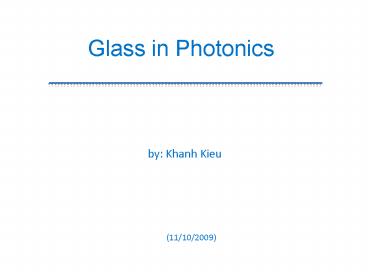Glass in Photonics - PowerPoint PPT Presentation
1 / 32
Title: Glass in Photonics
1
Glass in Photonics
by Khanh Kieu
(11/10/2009)
2
Outlines
1. Glass Fundamentals
- What is glass?
- How to make glass?
- Types of glass
- Physical properties
- Optical properties
2. Applications
- Fiber optics communication
- Data storage, laser-induced phase transition
- Microcavity
- Near-field optics
3. Fiber lasers and amplifiers
3
Glass material of many uses
Brief History Bottles (3500 years)
Windows (2000 years) Telescope Microscope
Lenses (1590 Netherlands) Mirrors(1680
France) Light Bulbs (1926) Float Glass
(Pilkington , 1959) Glass Laser (1960)
Optical Fiber (1970)
Egypt, 1400-1360 B.C.
Telescope Mirror, College of Optical Sciences
4
What is glass?
1945 American Society for Testing
Materials Glass is a an inorganic product of
fusion which has cooled to a rigid condition
without crystallization Satisfactory for
glasses most familiar to us windows, containers
But new methods other than cooling a melt were
developed sputtering, sol gels
1976 Glass is an X-ray amorphous material
which exhibits the glass transition, this is
being defined as the phenomenon in which a solid
amorphous phase exhibits with changing
temperature a more or less sudden change in the
derivative thermodynamic properties, such as heat
capacity and expansion coefficient, from
crystal-like to liquid like values.
5
Glass structure
Glasses have the mechanical rigidity of crystals,
but the random disordered arrangement of
molecules that characterizes liquids
6
How to determine a materials structure?
Crystals well-defined peaks Amorphous a halo is
seen
7
Properties of glassy state
- Lack of long range repeatable order,
non-crystalline - structure
- Typically produced from the liquid state by
continuous - cooling
- Exhibits what is known as the glass transition
- Can be formed from most liquids, provided
cooling - rate is sufficiently high
8
Thermal behavior of glass
Most materials Viscosity of melt water
(10-2Pas) Cooling melt ? rapid crystallization
Tm
- Glass forming materials
- Melt with considerable higher viscosity
- Significantly less crystallization below Tm
- If crystallization rate is low enough fast
cooling below Tm w/o crystallization possible - further cooling viscosity rising to such high
values that the mechanical properties become
similar to a solid
9
Thermal behavior of glass viscosity
Typical dependence of viscosity of a glass on
temperature
10
How to make glass?
- Mix and heat a composition of chemicals to high
temperature - Keep the mixture at high temperature for
chemical reaction - Quickly reduce the temperature to annealing
point - Anneal at moderate temperature to reduce
internal stresses - Slowly bring to room temperature
Movie ?
11
Types of glass
Typically glass composes of a glass network
former and several glass network modifiers
Classification based on glass network formers
- Silica SiO2
- Fluorides ZrF4, BaF2
- Phosphates P2O5
- Chalcogenides Se, Te
12
Optical properties Transmission window
Vibrational phonon absorption edge
Transmission window
13
Optical properties Transmission window
14
Refractive index
Fused silica 1.46 Soda-Lime glass
1.518 ZBLAN 1.5 Pb-silicate glass 2.5 Fused
quartz 2.126
15
Dispersion
Dependence of refractive index on wavelength
Normal dispersion in transparent
window Anomalous dispersion at resonances
Abbe number
16
Color and active glass
17
Color and active glass
Nd3, Yb3
Er3
Pr3 (491nm,520nm,605nm,695nm)
Tm3, Ho3
Er3, ZBLAN
Bi3
Pr3
3?m
1?m
2?m
1.5?m
0.5?m
Movie ?
18
Fiber optics telecommunication
Source telegeography.com
19
Fiber optics telecommunication
Daniel Colladon first described this "light
fountain" or "light pipe" in an 1842 article
entitled On the reflections of a ray of light
inside a parabolic liquid stream. This particular
illustration comes from a later article by
Colladon, in 1884
20
Fiber optics telecommunication
1. Low loss optical fiber based on fused
silica 2. Compact, low-cost diode lasers
21
Fiber optics telecommunication
Predict the loss in optical fiber could be lt
20dB/km Loss was 1000dB/km at that time
22
Fiber optics telecommunication
23
Data storage
Recording layer is a phase change material from
the group of Chalcogenides glasses Examples
AgInSbTe, GeSbTe, GeBiTe
24
Data storage Phase transition kinetics
25
Data storage Phase transition kinetics
ns laser amorphization
ns laser crystalization
26
Laser modification of glass ceramics
Movie ?
27
Microcavity
Source http//www.vahala.caltech.edu/
28
Laser fabrication of microsphere
Movie ?
29
Laser fabrication of microsphere
Reflector with ultra-narrow reflection bandwidth
Next lecture
30
Near-field probe, micropipette
Near-field image of a SWCNT (Prof.
Novotnys group)
Schematic diagram of a NSOM
(Laserfocusworld.com)
Near field fiber tip
31
The world smallest laser gyroscope?
- Basic elements
- Micro-ring laser
- Near-field probe
- Fiber taper
32
Summary
1. Glass Fundamentals
- What is glass?
- How to make glass?
- Types of glass
- Physical properties
- Optical properties
2. Applications
- Fiber optics communication
- Data storage, laser-induced phase transition
- Microcavity
- Near-field optics
3. Fiber lasers and amplifiers Lecture on this
Thursday































